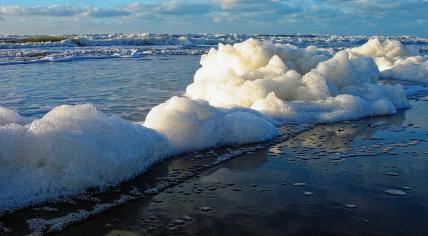
PFAS: Netherlands residents advised to keep kids, dogs away from sea foam
The Dutch government quietly tightened its advice on sea foam without reporting about it, NOS discovered. The advice now warns beachgoers to not let children and dogs play in sea foam because it contains high concentrations of PFAS. The warning is only on one government website and has recently been added to the swimming water app.
At the end of last year, the public health institute RIVM released a report warning of high PFAS concentrations in sea foam on the Dutch coast. PFAS stands for poly- and perfluoroalkyl substances. It is a collective name for thousands of manmade, non-degradable chemicals used since the 1950s in things like non-stick coatings on pans, waterproof clothing, and firefighting foam. PFAS are generally toxic and accumulate in the food chain. They can affect the immune system, and some types are carcinogenic with long-term exposure.
Until July, the Dutch government advised people to rinse themselves off after a day at the beach and to ensure that children and pets swallow as little sea foam as possible. This month, the government adjusted the advice and now warns to stay away from sea foam completely. “Do not allow children and pets to play in sea foam” can be read on the government website zwemwater.nl.
Chiel Jonker, an environmental chemist and PFAS expert at Utrecht University, praised the government's adjustment of the sea foam advice but criticized the lack of communication. “The advice has only been posted on zwemwater.nl. You won’t reach anyone with that. So they are hiding the advice, possibly to prevent panic,’ he told NOS.
“We have to look for ways to ingest less PFAS. We already ingest too much through food and drinks, but you cannot stop that. Avoiding contact with sea foam is something you can do,” Jonker said. He added that people don’t have to avoid the beach completely, just don’t play in the sea foam and wash off afterwards.
The Ministry of Infrastructure told NOS that the warning is “no tightening of the policy of new advice” but a “different choice of words to remove ambiguities.”
The Ministry said that it couldn’t possibly estimate how many people know that they shouldn’t let their kids or pets play in the sea foam. The information on the Dutch website zwemwater.nl/PFAS has been viewed by “several thousand people” this year. The Ministry also added the advice to the swimming water app a week ago. The broadcaster pointed out that many million s of people go to the beach every year.
Jonker thinks the warning would be much more effective on sings at the beach entrances in different languages. That was considered at the national swim water consultation of Rijkswaterstaat, RIVM, water boards, provinces, and GGD. But the provinces ultimately decided against it. They “consider it better not to place warning signs for sea foam,” NOS found in the minutes of the meeting held in February.
The Ministry and provinces told the broadcaster they decided against signs because there is “no immediate danger” and beach visitors “often do not look at the signs at the beach and regularly ignore warnings.” It is unclear why the warning on the website is different. The Ministry and provinces also said that beach visitors are responsible for informing themselves properly.
According to the Ministry, economic motives, such as a possible negative impact on tourism, did not influence its decision not to actively warn beachgoers to stay away from sea foam.
